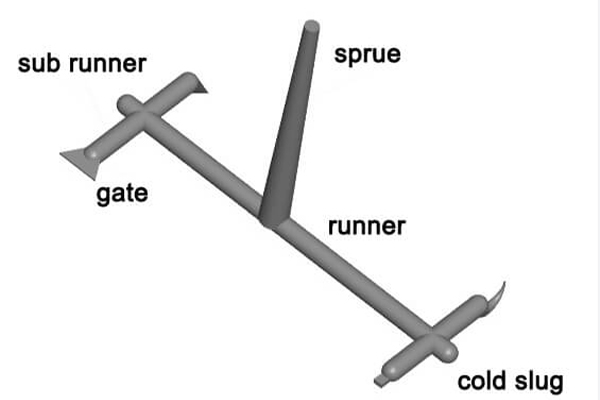What Are Injection Molding Sprues?
In the field of plastic injection molding, sprues play a vital role in the production process. It is the channel that guides molten plastic into the mold cavity, which directly affects the quality and appearance of the final product. The design and location of the sprue determines the uniformity of plastic flow and whether defects will occur during the molding of the product. Another important point is that sprues are also closely related to key factors such as scrap recycling and smooth demoulding, which have a profound impact on the entire production cycle. If you would like to learn more about the importance of sprues, continue reading below.

What is a sprue?
In the realm of injection molding, a sprue serves as the conduit for directing molten plastic into the mold. To be more precise, the sprue functions as the initial entry point for the molten plastic, forming a vertical passage through which the plastic subsequently flows into runners and gates. Collectively, this entire system is commonly referred to as the “sprues.” When inspecting components of a toy model, for instance, the primary parts are the ultimate end products produced within the mold cavities, while the interconnecting plastic structures within the sprues and runners serve as channels for cooling.
What Is Sprue Injection Molding?
Sprue injection molding, also known as sprue gating, is a common technique in the injection molding process. It involves the use of a sprue, which is a channel or passage through which molten plastic is directed from the injection molding machine into the mold cavity. The sprue serves as the initial entry point for the molten plastic.
The key features of sprue injection molding include:
-
- Sprue Design: The design of the sprue is crucial for controlling the flow of molten plastic and ensuring even distribution within the mold cavity. Proper sprue design helps prevent defects like air bubbles and incomplete fill.
- Runner System: The sprue is often connected to a runner system, which further directs the molten plastic to the mold’s cavities through gates. Runners are typically designed to be thinner than the mold’s parts to conserve material and reduce waste.
- Gate Location: The location of the gate, where the molten plastic enters the mold cavity from the runner, is also a critical factor. Gate placement affects the appearance and integrity of the final product.
- Waste Management: One challenge with sprue injection molding is managing the waste material generated by the sprues and runners. This plastic waste can be collected, melted down, and recycled to reduce environmental impact and material costs.
Sprue injection molding is a versatile technique used in various industries to manufacture a wide range of plastic products. Proper design and optimization of the sprue, runner system, and gate are essential to ensure high-quality, defect-free, and efficient production.
Sprues and Recycling
When the final product components are separated from the sprue, a significant amount of plastic waste can accumulate, which is sometimes considered a drawback of this injection molding process. Nevertheless, the residual sprue holds valuable potential. It can be gathered, melted, and transformed into recyclable plastic, primed to undergo the injection molding process once more. This recycling of leftover sprues not only mitigates waste but also actively contributes to sustainability and resource efficiency in injection molding.
Sprues and Hot Runners
An innovative departure from traditional “cold” sprues and runner systems is the introduction of hot runners. In this method, the overall process remains largely unchanged, but there’s a significant difference – the plastic is maintained in a heated state, ensuring it never solidifies within the runners. This transformative approach enables notably accelerated production and eradicates the necessity of collecting and recycling cooled plastic material, streamlining the injection molding process.
Hot Sprue Bushings
Hot sprue bushings are heated components designed to maintain the molten state of plastic that would otherwise solidify into a rigid stem. In contrast to hot runners, these bushings exclusively keep the sprue itself molten, without affecting the runners or sub-runners. The deployment of hot sprue bushings serves to diminish material wastage and marginally shorten cycle times, particularly beneficial because the sprue usually has the lengthiest cooling period. This approach can be perceived as a transitional solution, combining the convenience of cold runners with the efficiency of hot runners in the realm of injection molding.
Choosing the Right Sprue Configuration
The selection of the ideal sprues, runners, and gates design hinges on the specific product being manufactured. Considerations vary depending on the material used; for instance, products crafted from ABS, a common injection molding material, may necessitate larger runners compared to materials like nylon. Furthermore, the size and thickness of the product play a substantial role in runner design. Larger cavities, in particular, call for more extensive and precise gates, serving as the final pathway for plastic flow into the mold.
Sungplastic–Your Professional Partner in Injection Molding
Sungplastic is an experienced injection molding manufacturer with more than ten years of production experience, advanced technical equipment, and a creative and experienced team of engineers. With our rich expertise, we provide you with professional advice and suggestions on material selection, sprue design, manufacturing processes and surface finish. Not only are we committed to manufacturing excellence, we also focus on collaborating with our customers to ensure that your individual needs are met.
If you have any additional needs or questions, please feel free to contact us. We look forward to providing you with tailor-made solutions to meet your project requirements and expectations.
Get a free quote and design analysis today.
We’ll reply to you within 6 working hours.
We respect your privacy.
+86 139 2927 4777 (WhatsApp, Wechat)
